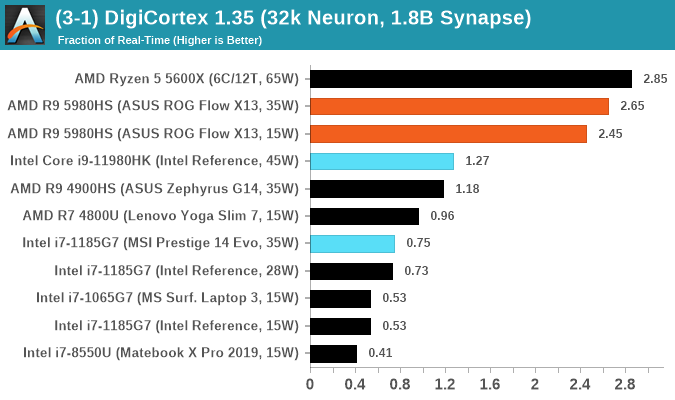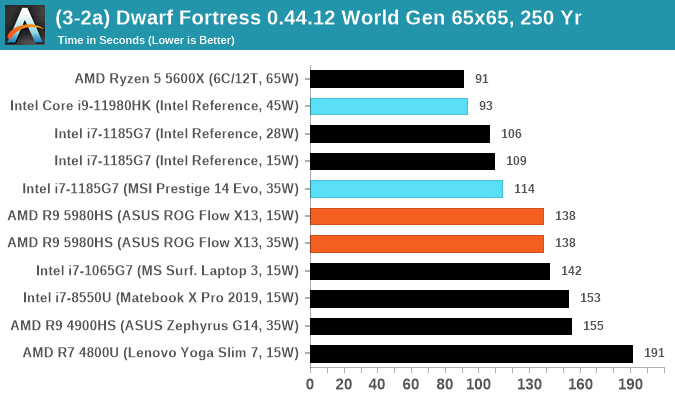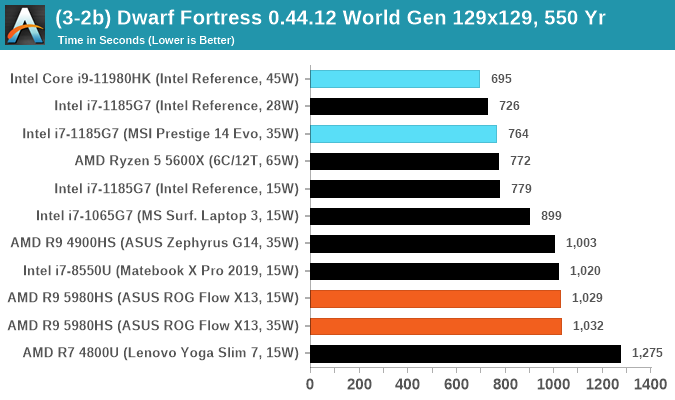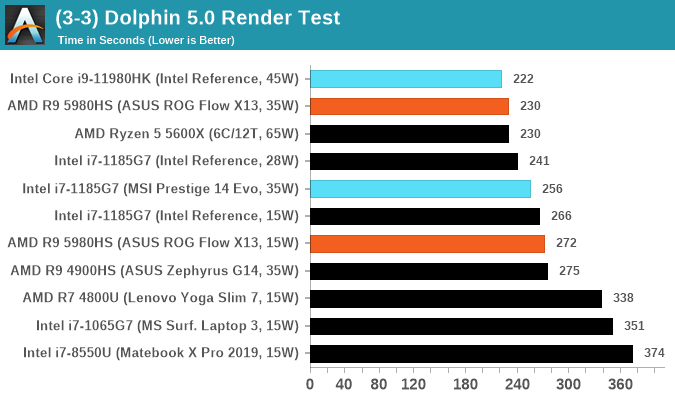Intel 11th Generation Core Tiger Lake-H Performance Review: Fast and Power Hungry
by Brett Howse & Andrei Frumusanu on May 17, 2021 9:00 AM EST- Posted in
- CPUs
- Intel
- 10nm
- Willow Cove
- SuperFin
- 11th Gen
- Tiger Lake-H
CPU Tests: Simulation
Simulation and Science have a lot of overlap in the benchmarking world, however for this distinction we’re separating into two segments mostly based on the utility of the resulting data. The benchmarks that fall under Science have a distinct use for the data they output – in our Simulation section, these act more like synthetics but at some level are still trying to simulate a given environment.
DigiCortex v1.35: link
DigiCortex is a pet project for the visualization of neuron and synapse activity in the brain. The software comes with a variety of benchmark modes, and we take the small benchmark which runs a 32k neuron/1.8B synapse simulation, similar to a small slug.
The results on the output are given as a fraction of whether the system can simulate in real-time, so anything above a value of one is suitable for real-time work. The benchmark offers a 'no firing synapse' mode, which in essence detects DRAM and bus speed, however we take the firing mode which adds CPU work with every firing.
The software originally shipped with a benchmark that recorded the first few cycles and output a result. So while fast multi-threaded processors this made the benchmark last less than a few seconds, slow dual-core processors could be running for almost an hour. There is also the issue of DigiCortex starting with a base neuron/synapse map in ‘off mode’, giving a high result in the first few cycles as none of the nodes are currently active. We found that the performance settles down into a steady state after a while (when the model is actively in use), so we asked the author to allow for a ‘warm-up’ phase and for the benchmark to be the average over a second sample time.
For our test, we give the benchmark 20000 cycles to warm up and then take the data over the next 10000 cycles seconds for the test – on a modern processor this takes 30 seconds and 150 seconds respectively. This is then repeated a minimum of 10 times, with the first three results rejected. Results are shown as a multiple of real-time calculation.

Dwarf Fortress 0.44.12: Link
Another long standing request for our benchmark suite has been Dwarf Fortress, a popular management/roguelike indie video game, first launched in 2006 and still being regularly updated today, aiming for a Steam launch sometime in the future.
Emulating the ASCII interfaces of old, this title is a rather complex beast, which can generate environments subject to millennia of rule, famous faces, peasants, and key historical figures and events. The further you get into the game, depending on the size of the world, the slower it becomes as it has to simulate more famous people, more world events, and the natural way that humanoid creatures take over an environment. Like some kind of virus.
For our test we’re using DFMark. DFMark is a benchmark built by vorsgren on the Bay12Forums that gives two different modes built on DFHack: world generation and embark. These tests can be configured, but range anywhere from 3 minutes to several hours. After analyzing the test, we ended up going for three different world generation sizes:
- Small, a 65x65 world with 250 years, 10 civilizations and 4 megabeasts
- Medium, a 127x127 world with 550 years, 10 civilizations and 4 megabeasts
- Large, a 257x257 world with 550 years, 40 civilizations and 10 megabeasts
DFMark outputs the time to run any given test, so this is what we use for the output. We loop the small test for as many times possible in 10 minutes, the medium test for as many times in 30 minutes, and the large test for as many times in an hour.


Dolphin v5.0 Emulation: Link
Many emulators are often bound by single thread CPU performance, and general reports tended to suggest that Haswell provided a significant boost to emulator performance. This benchmark runs a Wii program that ray traces a complex 3D scene inside the Dolphin Wii emulator. Performance on this benchmark is a good proxy of the speed of Dolphin CPU emulation, which is an intensive single core task using most aspects of a CPU. Results are given in seconds, where the Wii itself scores 1051 seconds.













229 Comments
View All Comments
eastcoast_pete - Monday, May 17, 2021 - link
A key question is now if Intel can further improve its 10 nm superfin process in time for Alder Lake. This TL is at least getting somewhat close to AMD's monolithic Zen3, but Rembrandt is around the corner, and that'll be an even more capable competitor. Right now, Intel retains its market share mostly because AMD can't deliver as many CPUs as people would buy.hfm - Monday, May 17, 2021 - link
I'm looking forward to an i5 or i7 design with no dGPU and that sweet embedded TB4. Probably going to be a small subset of the offerings like the lower tier XPS 15/17. Interested to see what comes about later in summer.evilspoons - Monday, May 17, 2021 - link
It'd be helpful to see power-normalized graphs, some of these results are a bit of a double-edged sword.outsideloop - Monday, May 17, 2021 - link
I want to see a comparison of the 11980HK with the 5800X clocked down to 65W, apples to apples. Let's compare the thermals of the AMD 8-core desktop to this "desktop replacement" Intel 8-core.Hifihedgehog - Monday, May 17, 2021 - link
Core i9-11980HK:https://images.anandtech.com/doci/16680/P95-45W_57...
Ryzen 9 5980HK:
https://images.anandtech.com/doci/16446/Power-P95-...
Just to add some further insight on these two charts, here is some breakdown. What ultimately happens is under sustained heavy loads, Ryzen 5000 series can maintain 8 cores at higher sustained clock speeds (~3.7 GHz) with lower power draw (35W). Bear in mind also that Zen 3 has a slight IPC advantage over Tiger Lake, meaning at a lower clock speed, it performs the same or does the same amount of work as Tiger Lake at a higher clock speed. Yet here we are where Ryzen 5000 can clock higher, do even MORE work, and draw less power. Meanwhile, Intel is struggling to reach similar sustained clock speeds (~3.2 GHz) at 45W sustained and it has slightly lower IPC. That is, Ryzen 5000 is ~10% faster clock-for-clock (or in IPC) than Intel's Willow Cove (Tiger Lake 11th Gen), Cypress Cove (Rocket Lake 11th Gen) or Sunny Cove (Ice Lake 10th Gen) which all three share roughly the same IPC amongst the whole trio (link: https://www.guru3d.com/articles_pages/intel_core_i... ). Ryzen 5000's synergy (higher clocks, lower power, higher IPC) sounds like a recipe for disaster for Intel, no? Alder Lake needs to come sooner rather than later if you ask me. Let's just hope Intel is throwing the full weight of their massive workforce of software developers at the problem of Alder Lake's heterogenous architecture because they will certainly need it working smoothly for it to shine.
lmcd - Monday, May 17, 2021 - link
Can we pause to note that MSI delivering bad thermal performance is characteristic of every single one of their laptops, bar none?lmcd - Monday, May 17, 2021 - link
Like, obviously that doesn't solve all the problems here, but how on earth with all the delays TGL-H(45+) got is this the OEM Intel picked?Spunjji - Tuesday, May 18, 2021 - link
It's a very odd choice. But then, didn't they use MSI for the original TGL reference platform too? That one actually outperformed most shipping devices, although IIRC it did so by running the fans at 100% 🤷♂️lmcd - Tuesday, May 18, 2021 - link
I put it on twitter also but my opinion is that the Tiger Lake MSI design is actually about the cooling and size that MSI would use for an H series processor normally, such as the MSI Creator.This implies that the MSI's thermal overhead is pure luck on Intel's part in that MSI didn't have time to reduce the thermal performance accordingly.
Spunjji - Thursday, May 20, 2021 - link
That would make sense!